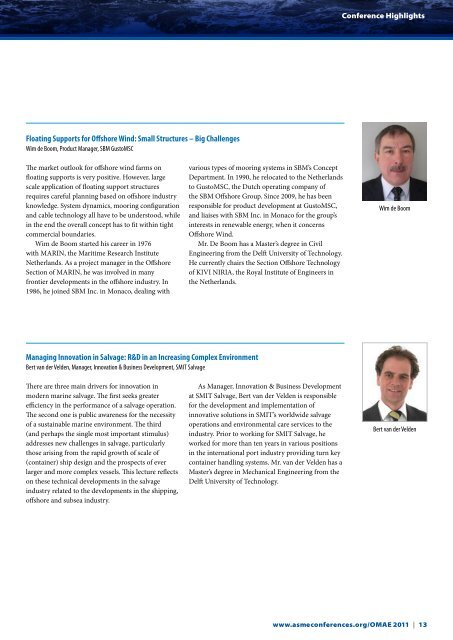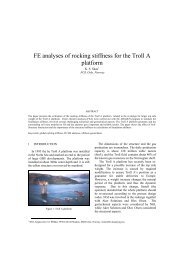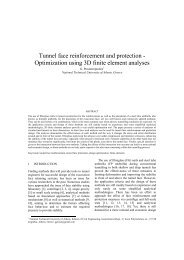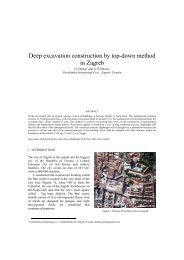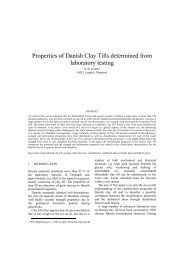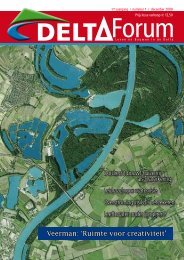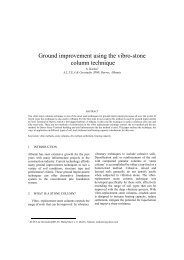OCEAN, OFFSHORE and ARCTIC ENGINEERING - Kivi Niria
OCEAN, OFFSHORE and ARCTIC ENGINEERING - Kivi Niria
OCEAN, OFFSHORE and ARCTIC ENGINEERING - Kivi Niria
Create successful ePaper yourself
Turn your PDF publications into a flip-book with our unique Google optimized e-Paper software.
Floating Supports for Offshore Wind: Small Structures – Big Challenges<br />
Wim de Boom, Product Manager, SBM GustoMSC<br />
The market outlook for offshore wind farms on<br />
floating supports is very positive. However, large<br />
scale application of floating support structures<br />
requires careful planning based on offshore industry<br />
knowledge. System dynamics, mooring configuration<br />
<strong>and</strong> cable technology all have to be understood, while<br />
in the end the overall concept has to fit within tight<br />
commercial boundaries.<br />
Wim de Boom started his career in 1976<br />
with MARIN, the Maritime Research Institute<br />
Netherl<strong>and</strong>s. As a project manager in the Offshore<br />
Section of MARIN, he was involved in many<br />
frontier developments in the offshore industry. In<br />
1986, he joined SBM Inc. in Monaco, dealing with<br />
Managing Innovation in Salvage: R&D in an Increasing Complex Environment<br />
Bert van der Velden, Manager, Innovation & Business Development, SMIT Salvage<br />
There are three main drivers for innovation in<br />
modern marine salvage. The first seeks greater<br />
efficiency in the performance of a salvage operation.<br />
The second one is public awareness for the necessity<br />
of a sustainable marine environment. The third<br />
(<strong>and</strong> perhaps the single most important stimulus)<br />
addresses new challenges in salvage, particularly<br />
those arising from the rapid growth of scale of<br />
(container) ship design <strong>and</strong> the prospects of ever<br />
larger <strong>and</strong> more complex vessels. This lecture reflects<br />
on these technical developments in the salvage<br />
industry related to the developments in the shipping,<br />
offshore <strong>and</strong> subsea industry.<br />
various types of mooring systems in SBM’s Concept<br />
Department. In 1990, he relocated to the Netherl<strong>and</strong>s<br />
to GustoMSC, the Dutch operating company of<br />
the SBM Offshore Group. Since 2009, he has been<br />
responsible for product development at GustoMSC,<br />
<strong>and</strong> liaises with SBM Inc. in Monaco for the group’s<br />
interests in renewable energy, when it concerns<br />
Offshore Wind.<br />
Mr. De Boom has a Master’s degree in Civil<br />
Engineering from the Delft University of Technology.<br />
He currently chairs the Section Offshore Technology<br />
of KIVI NIRIA, the Royal Institute of Engineers in<br />
the Netherl<strong>and</strong>s.<br />
As Manager, Innovation & Business Development<br />
at SMIT Salvage, Bert van der Velden is responsible<br />
for the development <strong>and</strong> implementation of<br />
innovative solutions in SMIT’s worldwide salvage<br />
operations <strong>and</strong> environmental care services to the<br />
industry. Prior to working for SMIT Salvage, he<br />
worked for more than ten years in various positions<br />
in the international port industry providing turn key<br />
container h<strong>and</strong>ling systems. Mr. van der Velden has a<br />
Master’s degree in Mechanical Engineering from the<br />
Delft University of Technology.<br />
Conference Highlights<br />
Wim de Boom<br />
Bert van der Velden<br />
www.asmeconferences.org/OMAE 2011 | 13


